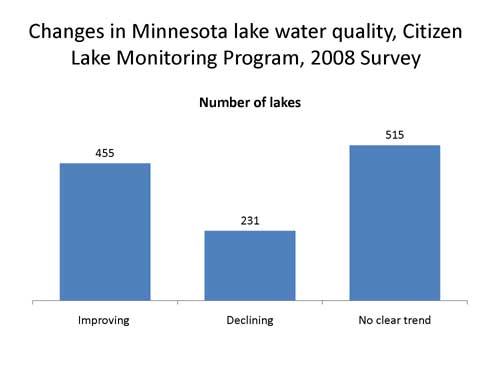Indicator 54: Lake water quality


Goal: Minnesotans will improve the quality of the air, water and earth.
Rationale: Water quality affects the desirability of a lake for fishing, swimming and other recreation. Extreme cases of poor water quality can produce toxic algae blooms.
About this indicator: Results of the Citizen Lake Monitoring Program show substantially more lakes with improving water quality, 455, than with decreasing water quality, 231. The remaining 515 lakes showed no clear trend. Only lakes with 8 or more years of data are included in the trend analysis. A Seasonal Kendall test was used to determine whether the data for each lake show increasing or decreasing trends.

| Changes in Minnesota lake water quality measured by Citizen Lake Monitoring Program, 2008 survey | ||
| Total improving | 455 | |
| Possibly improving | 67 | |
| Likely improving | 47 | |
| Very likely improving | 113 | |
| Almost certainly improving | 228 | |
| Total declining | 231 | |
| Possibly declining | 50 | |
| Likely declining | 38 | |
| Very likely declining | 53 | |
| Almost certainly declining | 90 | |
| No clear trend | 515 | |
For comparison: Typical Secchi disk measures vary by ecoregion. They are highest in the Northern Lakes and Forests ecoregion in northeastern Minnesota. The Northern Glaciated Plains and Western Cornbelt Plains ecoregions in southern Minnesota have the lowest Secchi measures.
Technical notes: In 2008, 1302 Minnesota volunteers monitored the quality of 1317 lakes in the state. Participants take weekly transparency measurements on their lakes using a Secchi disk. A Secchi disk is a circular disk with a distinct pattern. The disc is lowered into the water, and the depth at which the pattern is no longer visible is used as a measure of transparency. At least eight to ten readings per season are needed to give reliable results.
Secchi transparency (clarity) is a measure of the depth of light penetration in the water column. Factors affecting water clarity include suspended sediments, precipitation and algae.
Sources:
- Minnesota Pollution Control Agency, http://www.pca.state.mn.us/water/clmpfactsheets.html
Local data:




